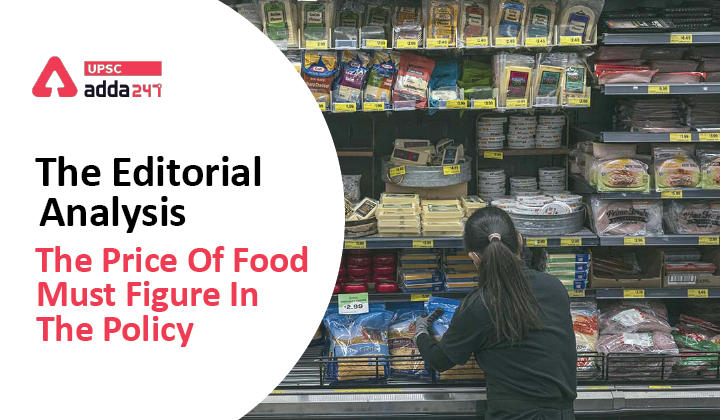Table of Contents
Food Prices in India: Relevance
- GS 2: Government policies and interventions for development in various sectors and issues arising out of their design and implementation.
Food Prices in India: Context
- The farm laws—which have been repealed— were projected as a means of raising farm revenues via higher prices of agricultural commodities. It is similar to other attempt by the Government where the focus is on Minimum Support Prices (MSP) and other subsidies and less on the food prices.
Impact of higher price of food
- High price of food can trigger economic insecurity for the individual.
- For the household, a high price of food crowds out expenditure on other items ranging from health and education to non-agricultural goods.
- This prevents the market for non-agricultural goods from expanding, which is necessary for the non-agricultural economy to grow.
- Share of food in a household’s budget is very large for India. Data from the U.S. Department of Agriculture (2016) show that this share ranges from over 30% for India to less than 10% for the U.S. and the U.K.
- Countries with higher per capita income have a lower share of food in consumption expenditure
- This is in line with Ricardo’s understanding of how economies progress i.e., as food gets cheaper, growth in the non-agricultural economy is stimulated.
Flawed agricultural policy of India
- Agricultural policy in India has remained quite unaccountable as the food prices are continuously increasing. For instance, the relative price of food has risen over 50% since 1991.
- This increase in food prices is out of line with the global experience of development.
- 1991 reforms led to success in services sector. However, it has also led to increase in food prices.
- This increase in price of food has led to lack of expansion of the manufacturing sector in India.
Agriculture sector of India
- Agriculture, unlike industrial production, is affected by fluctuation in the weather, which makes it risky.
- Public investment in the 1960s—when India was facing food shortage— had raised the agricultural production.
- However, it introduced the strategy of ensuring farm profitability though favourable prices assured by the state.
- Further, due to unconditional purchase from the state, grain stockpiles started accumulating.
- These stocks have often rotted, resulting in deadweight loss, paid for by the public through taxes or public borrowing.
- Finally, with all costs of production reimbursable and all of output finding an assured outlet, supply has outstripped demand. This has led to an unimaginable pressure on the natural environment, especially water supply.
Agricultural policy of India: Way forward
- India needs an agricultural policy that ensures that farming is profitable but not at the cost of a high price of food.
- The ‘food problem’ should no longer be seen only in terms of the availability of food from domestic sources.
- Raising yields will ensure profitability without raising producer prices, which will inflate the food subsidy bill. When negotiating with the farmers, the government must protect the interests of the poor of India.
lso Read:










 TSPSC Group 1 Question Paper 2024, Downl...
TSPSC Group 1 Question Paper 2024, Downl...
 TSPSC Group 1 Answer key 2024 Out, Downl...
TSPSC Group 1 Answer key 2024 Out, Downl...
 UPSC Prelims 2024 Question Paper, Downlo...
UPSC Prelims 2024 Question Paper, Downlo...




